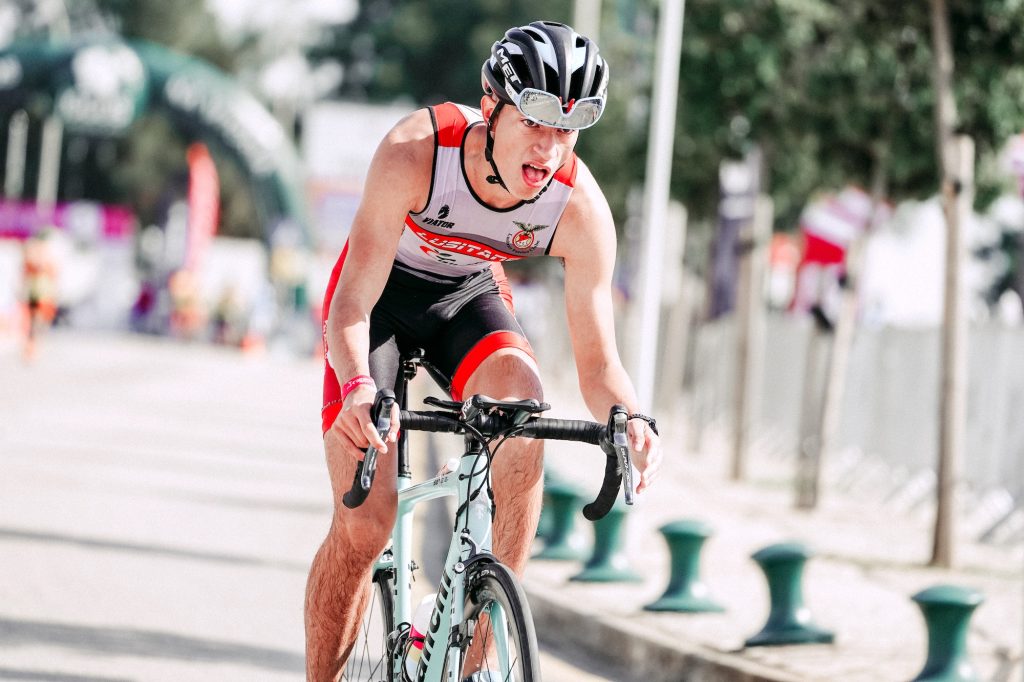From styles designed for efficient racing to futuristic fabrics that offer sun protection and less drag, tri suits have come a long way. And they’re getting even better
Photos by RUN 4 FFWPU/Pexels
In 1974 and with just 46 participants, the first modern-day triathlon was held in Mission Bay, California. In its early days, triathlon was not known for its modesty, as racers were wont to unabashedly strip off their bottoms during transitions. Since then, as the popularity of triathlon has snowballed, so has the need for tri-specific gear. Interestingly, it wasn’t the self-consciousness of public nudity that sparked the development of gear; rather, it was the need to shave precious seconds, as changing outfits during transitions only added to one’s overall time.
After racers and sporting companies realized that switching from swim to bike to run shorts was too tedious, hybrid bottoms were born. These thick, padded bike shorts were hydrodynamic in the water and afforded the wearer mild compression of the muscles. But there was a trade-off—the ease that the shorts gave the athlete during the swim and bike legs was lost during the run segment because the thick cushioning made it very unnatural to move in.
In its early days, triathlon was not known for its modesty, as racers were wont to unabashedly strip off their bottoms during transitions
To address this, manufacturers produced the tri suit, a one-piece kit that had enough flexibility to go through all three phases. The main problem with the hybrid wear, however, was offering the right fit for racers of various body types. This paved the way for yet another tweak in the design, one that resulted in the most popular type of triathlon gear today—the two-piece tri suit. The separates allow athletes to customize their outfit with the right size (and sometimes brand) for their top and bottom, all tailor-fit to their comfort.
Today, tri suit choices are endless. The amount of technology and research that go into each piece of apparel is extensive—and it is only growing. Companies such as Sugoi and Zoot have started using yarns with micro denier polyester that actively pull moisture away from the skin to evaporate sweat and water faster. Major progress also involves the integration of sun protection as high as 100 SPF. For those who race in high humidity, Xylitol yarn is being used to reduce the skin’s surface temperature by 1°C. Some suits even feature hydrophobic layers around the external fabric of the suit to minimize drag in the water during the swim. Because there are so many different competing brands, the cost of these new suits has become more affordable, making high-tech gear available to consumers in all price points.

We are at a turning point in the evolution of triathlon apparel. Harsher environments on race day are pushing companies to create more resilient wear. How this affects faster times and overall safety in the sport will unfold in the next few years. Indeed, in the realm of tri suit developments, we are all just merely spectators.
Four things to look for in a tri suit
- Compression along the large muscle groups such as the quadriceps and hamstrings to reduce fatigue.
- Exposed stitching equals more hydrostatic drag, so look for a suit that has the least amount possible.
- Aero is better. The suit should fit like second skin. Avoid baggy fits; this increases the drag and wind resistance.
- Choose sweat-wicking fabrics to assist with temperature regulation and minimize the risk of overheating.
Note: Both the USAT and WTC deem sleeved tri suits not legal during the swim segment of non-wetsuit legal swims
One piece or two piece? Sleeves or no sleeves?
Like the age-old argument of boxers or briefs, it comes down to personal preference
One piece
In sprint and Olympic distances, where every second counts, one-piece suits are the best option.
Two piece
Allows for easy access during potty breaks. Also best for longer races like the 70.3 and 140.6, wherein you may need to shed off some layers as the day progresses.
Sleeved
Remember, sleeved tri suits can only be used at the bike and run legs, not during the swim. That said, sleeved suits offer more wind resistance, and wind tunnel tests prove that they are more aerodynamic.













































